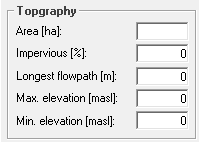Translations:Einzugsgebietsfenster/8/en: Unterschied zwischen den Versionen
Keine Bearbeitungszusammenfassung |
Keine Bearbeitungszusammenfassung |
||
| Zeile 1: | Zeile 1: | ||
[[Datei:Einzugsgebietsfenster Topographie_EN.PNG|right]]The data to be entered in the Topography section is | [[Datei:Einzugsgebietsfenster Topographie_EN.PNG|right]]The data to be entered in the Topography section is typically determined in a GIS. The area of the sub-basin is crucial for the amount of generated runoff, because the precipitation is processed into the Precipitation-Runoff-Modell as precipitation height [mm] and is, therefore, scaled with the area. | ||
The degree of sealing determines the proportion of sealed area in the total area and describes the proportion that runs off as urban surface runoff. The urban surface runoff is separated from the remaining natural surface runoff [[Special:MyLanguage/Einzugsgebiet#Oberflächenwasservorrat (versiegelter Flächenanteil)|calculated]] and retained in a separate [[Special:MyLanguage/Einzugsgebiet#Abflusskonzentration|storage cascade]]. The [[Special:MyLanguage/Einzugsgebietsfenster#Ablaufzuordnung|discharge allocation]] can also be used to assign it to a different discharge element. | The degree of sealing determines the proportion of sealed area in the total area and describes the proportion that runs off as urban surface runoff. The urban surface runoff is separated from the remaining natural surface runoff [[Special:MyLanguage/Einzugsgebiet#Oberflächenwasservorrat (versiegelter Flächenanteil)|calculated]] and retained in a separate [[Special:MyLanguage/Einzugsgebiet#Abflusskonzentration|storage cascade]]. The [[Special:MyLanguage/Einzugsgebietsfenster#Ablaufzuordnung|discharge allocation]] can also be used to assign it to a different discharge element. | ||
The input for longest flow distance and maximum and minimum height are used for the automatic calculation of the [[Special:MyLanguage/#retention--oberflächenabfluss|retention constants of surface runoff]]. | The input for longest flow distance and maximum and minimum height are used for the automatic calculation of the [[Special:MyLanguage/#retention--oberflächenabfluss|retention constants of surface runoff]]. | ||
Version vom 15. Dezember 2020, 09:12 Uhr
The data to be entered in the Topography section is typically determined in a GIS. The area of the sub-basin is crucial for the amount of generated runoff, because the precipitation is processed into the Precipitation-Runoff-Modell as precipitation height [mm] and is, therefore, scaled with the area.
The degree of sealing determines the proportion of sealed area in the total area and describes the proportion that runs off as urban surface runoff. The urban surface runoff is separated from the remaining natural surface runoff calculated and retained in a separate storage cascade. The discharge allocation can also be used to assign it to a different discharge element. The input for longest flow distance and maximum and minimum height are used for the automatic calculation of the retention constants of surface runoff.
